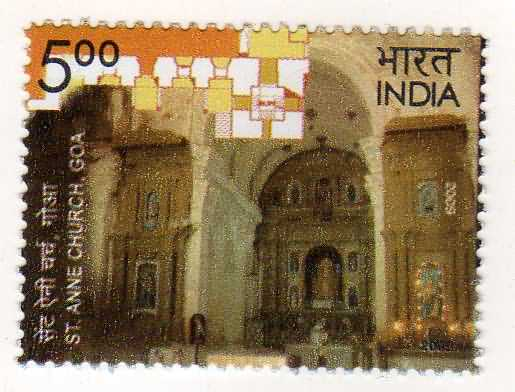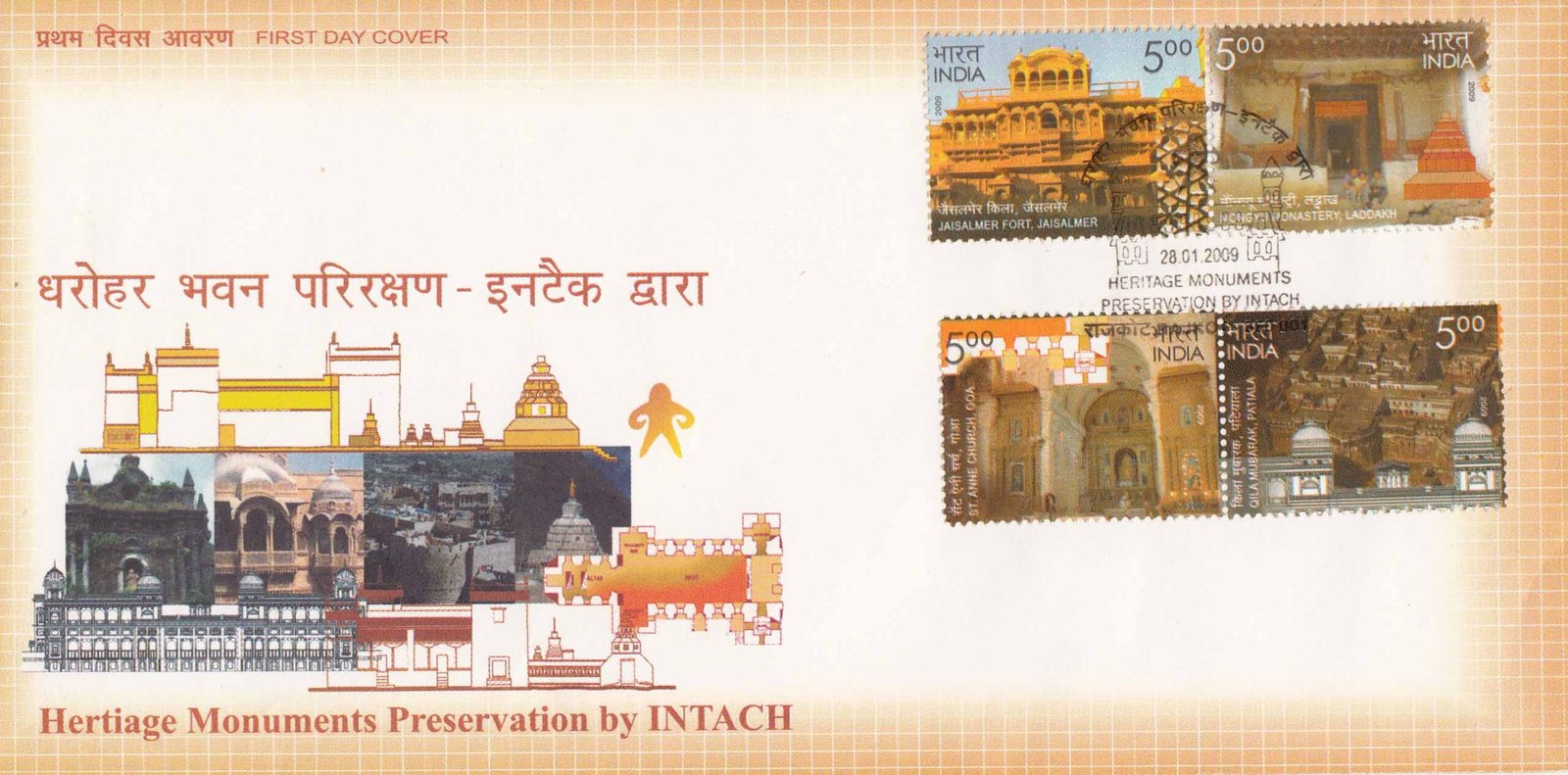Heritage Monuments Preservation by INTACH – Saint Anne’s Church Goa

Technical Data
| Stamp Set | Heritage Monuments Preservation by INTACH |
|---|---|
| Date of Issue | January 28, 2009 |
| Denomination | Rs. 5 |
| Quantity | 800,000 |
| Perforation | 13 |
| Printer | India Security Press, Nasik |
| Printing Process | Photo Gravure |
| Watermark | No Watermark |
| Colors | Multicolor |
| Credit (Designed By) | Sh. Bharati Mirchandani |
| Catalog Codes |
Michel IN 2344 Stamp Number IN 2308c Stanley Gibbons IN 2568 WADP Numbering System - WNS IN006.2009 |
| Themes | Churches-Cathedrals-Basilicas-Chapels | UNESCO World Heritage Sites |
India’s glorious history of more than 5000 years enumerates several civilizations that have been a constant reminder of the country’s rich multicultural extravaganza and world-renowned heritage which includes India’s arts, handicrafts, dance forms, musical styles and architectural monuments. To preserve our heritage is our duty to our future generations. Architectural preservation describes the process through which the material, historical, and design integrity of mankind’s built heritage are prolonged through carefully planned interventions. The Indian National Trust for Art and Cultural Heritage (INTACH) has shouldered this responsibility to protect and conserve India’s vast natural and cultural heritage. India Post issues a set of four commemorative postage stamps on Mangyu Monastery, Saint Annie’s Church Goa, Jaisalmer Fort and Qila Mubarak commemorating the efforts in preserving India’s architectural heritage.
Mangyu Monastery
Mangyu, a small village in Leh, derives its name from Mangyu river. It has Buddhist monasteries and Nag-Idar Chortern (Stupa) more than 1000 years old and these are believed to be built by Lhotsava Rin-Chen-Zang-Po (956–1042 AD) a legendary figure associated with the proliferation and advancement of Buddhism in Ladakh and the rest of the Western Himalayas as well as construction of Buddhist monasteries. The Monastery comprises of four temples. These are Nanggarmangad, Chenrezig Lhakhang, Chamba Lhakhang (Maitreya) and Chamba Lhakhang (Jambeyang).
The monastery has a simple exterior supplemented with rich art. All these rooms have a rich repository of wall paintings and stucco images. It is believed that Lhotsava, who built the monastery, had 32 Kashmiri craftsmen along with him, who had worked on the interior embellishments. Hence, the art forms of the monastery bear a distinct Kashmiri as well as Western Tibetan influences. Characteristic art forms include 2 stucco images of Chamba (nearly 4.5 metres high), 25 mandalas within Nanggarmangad and Chenrezig Lhakhang and 1000 miniature Buddhas drawn neatly in rows and columns.
The massive Church was built in 1681–95 in the village of Talaulim, located approximately 10–12 kms. from Panaji. This village once formed part of the larger metropolitan region of the Old City of Goa. The origins of the church date back to 1577 when the property was originally bought and a chapel constructed by priests attached to St. Paul’s College of Old Goa of the Jesuit order. The church to its present form was taken up for reconstruction in 1681 under Msgr. Francisco de Rego and completed in 1695 by his successor Fr. Antonio Francisco Da Cunha. The date is found engraved on the front main door. With the decline and abandonment of Old Goa in the 18th century and the shifting of the City to Panaji, these parts also declined considerably.
Jaisalmer Fort
In the midst of the Thar desert, the medieval fortress town of Jaisalmer rises like a city at the very end of the world. In this remote land palaces, havelis, temples and bazaars create a magical, almost surreal city. It is desertly dominated by the golden sandstone fortification, its ninety-nine bastions silhouetted against the sky. Jaisalmer Fort, built entirely of stone in the 12th century, is an awe-inspiring architectural feat. It is perhaps the world’s only living fort where the traditional patterns of life have continued over the centuries.
Qila Mubarak
Patiala is one of the youngest cities of Punjab. It was founded by Baba Ala in the middle of the eighteenth century as a military stronghold. In the heart of the city of Patiala lies the 10 acre Qila Mubarak Complex. Qila Mubarak is said to be the only Sikh fort of its kind in this side of the Punjab. Almost all other forts which exist in the state are either of Mughal or pre-Mughal origin. It is a planned, symmetrical building built in a synthesis of late Mughal and Rajasthani styles. The inner spaces are built to varying scales and styles. And the roof of the complex suggests a colonial afterthought in its architecture. Though the Androon is a single interconnected building, it was spoken of as a series of palaces. Each set of rooms clustered around a courtyard had a name: the Sheesh Mahal, the Rang Mahal, the Toshkhana the Jail Khana and the Chand Mahal.
These heritage structures have been erected by INTACH.
First Day Cover

